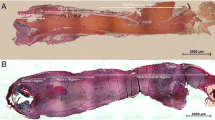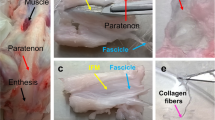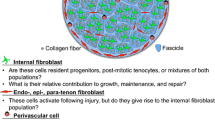Abstract
Purpose
Tendons generally exhibit poor healing capacity, probably due to slow cell regeneration potential and low vascularization. The potential to regenerate may partly be due to activation of stem/progenitor cells localized in the tendon or its vicinity. In the present study, we attempted to determine where in the rat Achilles tendon stem/progenitor cells reside and to investigate the effect of exercise on cell proliferation in the in vivo situation.
Method
We used bromodeoxyuridine (BrdU) labelling to investigate proliferation and label-retaining cells (i.e. slow-cycling cells) in non-exercised and exercised rats, in combination with immunostaining of the stem cell marker nucleostemin. Rat Achilles tendons were harvested 14, 28, 56 and 105 days after BrdU administration.
Results
We found the proportion of stem/progenitor cells to be twice as high in the distal tendon (DT) compared with the mid/proximal tendon (MPT) and that paratenon/endotenon regions appear to host a pool of existing stem/progenitor cells. Exercise increased the BrdU-stained cell population after 14 days only (DT region p = 0.032, MPT p = 0.065), indicating effect mainly on more differentiated cells, since the nucleostemin-positive cells (i.e. stem/progenitor cells) remained unaffected in the intact Achilles tendon.
Conclusion
Stem/progenitor cells exist in several areas of the rat Achilles tendon which implies a possible stem cell regeneration pool of different origins. The distal region has twice the amount of stem/progenitor cells compared with the mid/proximal region, indicating a potentially higher stem cell activity in this tissue. Daily moderate exercise (treadmill running) mainly improves in vivo cell proliferation in rapidly proliferating cells, whereas the stem/progenitor pool remains constant.







Similar content being viewed by others
References
Ackermann PW, Salo PT, Hart DA (2009) Neuronal pathways in tendon healing. Front Biosci 14:5165–5187
Benjamin M, Evans EJ, Copp L (1986) The histology of tendon attachments to bone in man. J Anat 149:89–100
Bi Y, Ehirchiou D, Kilts TM, Inkson CA, Embree MC, Sonoyama W, Li L, Leet AI, Seo BM, Zhang L, Shi S, Young MF (2007) Identification of tendon stem/progenitor cells and the role of extracellular matrix in their niche. Nat Med 13:1219–1227
Boushel R, Langberg H, Green S, Skovgaard D, Bulow J, Kjaer M (2000) Blood flow and oxygenation in peritendinous tissue and calf muscle during dynamic exercise in humans. J Physiol 524:305–313
Couppé C, Kongsgaard M, Aagaard P, Hansen P, Bojsen-Moller J, Kjaer M, Magnusson SP (2008) Habitual loading results in tendon hypertrophy and increased stiffness of the human patellar tendon. J Appl Physiol 105:805–810
Gineyts E, Cloos PA, Borel O, Grimaud L, Delmas PD, Garnero P (2000) Racemization and isomerization of type I collagen C-telopeptides in human bone and soft tissue: assessment of tissue turnover. Biochem J 345:481–485
Glazebrook MA, Wright JR, Langman M, Stanish WD, Lee JM (2008) Histological analysis of achilles tendons in an overuse rat model. J Orthop Res 26:840–846
Heinemeier KM, Olesen JL, Haddad F, Langberg H, Kjaer M, Baldwin KM, Schjerling P (2007) Expression of collagen and related growth factors in rat tendon and skeletal muscle in response to specific contraction types. J Physiol 582:1303–1316
Henriksson H, Thornemo M, Karlsson C, Hägg O, Junevik K, Lindahl A, Brisby H (2009) Identification of cell proliferation zones, progenitor cells and a potential stem cell niche in the intervertebral disc region: a study in four species. Spine (Phila Pa 1976) 34:2278–2287
Holm L, Reitelseder S, Pedersen TG, Doessing S, Petersen SG, Flyvbjerg A, Andersen JL, Aagaard P, Kjaer M (2008) Changes in muscle size and MHC composition in response to resistance exercise with heavy and light loading intensity. J Appl Physiol 105:1454–1461
Hong HS, Lee J, Lee E, Kwon YS, Lee E, Ahn W, Jiang MH, Kim JC, Son Y (2009) A new role of substance P as an injury-inducible messenger for mobilization of CD29(+) stromal-like cells. Nat Med 15:425–435
Karlsson C, Thornemo M, Henriksson HB, Lindahl A (2009) Identification of a stem cell niche in the zone of Ranvier within the knee joint. J Anat 215:355–363
Kim SJ, Cheung S, Hellerstein MK (2004) Isolation of nuclei from label-retaining cells and measurement of their turnover rates in rat colon. Am J Physiol Cell Physiol 286:C1464–C1473
Ksiezopolska-Orlowska K (2010) Changes in bone mechanical strength in response to physical therapy. Pol Arch Med Wewn 120:368–373
Maffulli N, Longo U, Sharma P, Denaro V (2010) Tendon injury and repair mechanics. In: Archer C, Ralphs J (eds) Regenerative medicine and biomaterials for the repair of connective tissue. Woodhead Publishing Limited, Cambridge, pp 394–418
Magnusson SP, Langberg H, Kjaer M (2010) The pathogenesis of tendinopathy: balancing the response to loading. Nat Rev Rheumatol 6:262–268
Orford KW, Scadden DT (2008) Deconstructing stem cell self-renewal: genetic insights into cell-cycle regulation. Nat Rev Genet 2:115–128
Potten CS, Morris RJ (1988) Epithelial stem cells in vivo. J Cell Sci Suppl 10:45–62
Sasaki N, Henriksson HB, Runesson E, Larsson K, Sekiguchi M, Kikuchi S, Konno S, Rydevik B, Brisby H (2012) Physical exercise affects cell proliferation in lumbar intervertebral disc regions in rats. Spine (Phila Pa 1976) 37:1440–1447
Skovgaard D, Bayer ML, Mackey AL, Madsen J, Kjaer M, Kjaer A (2010) Increased cellular proliferation in rat skeletal muscle and tendon in response to exercise: use of FLT and PET/CT. Mol Imaging Biol 12:626–634
Szczodry M, Zhang J, Lim C, Davitt HL, Yeager T, Fu FH, Wang JH (2009) Tredmill running exercise results in the presence of numerous myofibroblasts in mouse patellar tendon. J Orthop Res 27:1373–1378
Taylor G, Lehrer MS, Jensen PJ, Sun TT, Lavker RM (2000) Involvement of follicular stem cells in forming not only the follicle but also the epidermis. Cell 102:451–461
Tempfer H, Wagner A, Gehwolf R, Lehner C, Tauber M, Resch H, Bauer HC (2009) Perivascular cells of the supraspinatus tendon express both tendon- and stem cell-related markers. Histochem Cell Biol 131:733–741
Tsai RY, McKay RD (2002) A nucleolar mechanism controlling cell proliferation in stem cells and cancer cells. Genes Dev 16:2991–3003
Yang G, Crawford RC, Wang JH (2004) Proliferation and collagen production of human patellar tendon fibroblasts in response to cyclic uniaxial stretching in serum-free conditions. J Biomech 37:1543–1550
Zeichen J, van Griensven M, Bosch U (2000) The proliferative response of isolated human tendon fibroblasts to cyclic biaxial mechanical strain. Am J Sports Med 28:888–892
Zhang J, Pan T, Im HJ, Fu FH, Wang JH (2011) Differential properties of human ACL and MCL stem cells may be responsible for their differential healing capacity. BMC Med 9:68
Zhang J, Pan T, Liu Y, Wang JH (2010) Mouse treadmill running enhances tendons by expanding the pool of tendon stem cells (TSCs) and TSC-related cellular production of collagen. J Orthop Res 28:1178–1183
Zhang J, Wang JH (2010) Mechanobiological response of tendon stem cells: implications of tendon homeostasis and pathogenesis of tendinopathy. J Orthop Res 28:639–643
Zhang J, Wang JH (2010) Characterization of differential properties of rabbit tendon stem cells and tenocytes. BMC Musculoskelet Disord 11:10
Acknowledgments
The study was supported by grants from Sahlgrenska University Hospital, LUA/ALF Research project: 44931, Dr. Felix Neuberghs Foundation (ER) and by the regional agreement on medical training and clinical research (ALF) between Stockholm County Council and Karolinska Institutet (project nr. SLL20100168).
Author information
Authors and Affiliations
Corresponding author
Rights and permissions
About this article
Cite this article
Runesson, E., Ackermann, P., Brisby, H. et al. Detection of slow-cycling and stem/progenitor cells in different regions of rat Achilles tendon: response to treadmill exercise. Knee Surg Sports Traumatol Arthrosc 21, 1694–1703 (2013). https://doi.org/10.1007/s00167-013-2446-7
Received:
Accepted:
Published:
Issue Date:
DOI: https://doi.org/10.1007/s00167-013-2446-7




